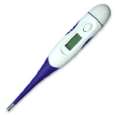 entle kiss on the forehead or a hand placed lightly on your child's sk
entle kiss on the forehead or a hand placed lightly on your child's sk in is often enough to tell that your child has a fever. However, this method of taking a temperature (called tactile temperature) is dependent on the person doing the feeling and doesn't give an accurate measure of a child's temperature.
in is often enough to tell that your child has a fever. However, this method of taking a temperature (called tactile temperature) is dependent on the person doing the feeling and doesn't give an accurate measure of a child's temperature.By using a reliable thermometer, you can tell if your child has a fever if his or her temperature is at or higher than one of the following levels:
* 100.4 degrees Fahrenheit (38 degrees Celsius) measured rectally (in the bottom)
* 99.5 degrees Fahrenheit (37.5 degrees Celsius) measured orally (in the mouth)
* 99 degrees Fahrenheit (37.2 degrees Celsius) measured in an axillary position (under the arm)
But how high a fever is doesn't tell you much about how sick your child is. A simple cold or other viral infection can sometimes cause a rather high fever (in the 102 to 104 degrees Fahrenheit, or 38.9 to 40 degrees Celsius, range), but doesn't usually indicate a serious problem. And serious infections may cause no fever or even an abnormally low body temperature, especially in young infants.
high a fever is doesn't tell you much about how sick your child is. A simple cold or other viral infection can sometimes cause a rather high fever (in the 102 to 104 degrees Fahrenheit, or 38.9 to 40 degrees Celsius, range), but doesn't usually indicate a serious problem. And serious infections may cause no fever or even an abnormally low body temperature, especially in young infants.
Because fevers may rise and fall, a child with fever may experience chill s, which occur when the body tries to generate additional heat when the body's temperature begins to rise. The child may sweat as the body releases extra heat when the temperature starts to drop.
s, which occur when the body tries to generate additional heat when the body's temperature begins to rise. The child may sweat as the body releases extra heat when the temperature starts to drop.
Sometimes children with a fever may also breathe faster than usual and may have a higher heart rate. You should call your child's doctor if your child is having difficulty breathing, is breathing a lot faster than normal, or continues to breathe fast after the fever comes down.
